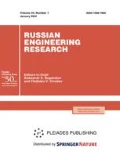Abstract
The relation between tool wear in metal turning and the reactive forces on the tool is studied experimentally. The experimental variation of the reactive forces observed experimentally during wear growth matches the sections of the wear curve: that is, stabilization of the forces is observed at first, but then the reactive forces increase sharply on approaching catastrophic wear. Extrapolation of the results on the basis of nonlinear models leads to the conclusion that the cutting forces depend quadratically on the wear at the rear face.




Similar content being viewed by others
REFERENCES
Loladze, T.N., Prochnost’ i iznosostoikost’ rezhushchego instrumenta (Durability and Wear Resistance of Cutting Tool), Moscow: Mashinostroenie, 1982.
Makarov, A.D., Optimizatsiya protsessov rezaniya (Optimization of Cutting Processes), Moscow: Mashinostroenie, 1976.
Zakovorotny, V.L., Lapshin, V.P., and Babenko, T.S., Modeling of tool wear: irreversible energy transformations, Russ. Eng. Res., 2018, vol. 38, no. 9, pp. 707–708.
Chou, Y.K. and Evans, C.J., Cubic boron nitride tool wear in interrupted hard cutting, Wear, 1999, vols. 225–229, pp. 234–245.
Lin, Z.C. and Chen, D.Y., A study of cutting with a CBN tool, J. Mater. Process. Technol., 1995, vol. 49, pp. 149–164.
Hu, J. and Chou, Y.K., Characterizations of cutting tool flank wear-land contact, Wear, 2007, vol. 263, no. 7, pp. 1454–1458
Liu, J., et al., Study on lubricating characteristic and tool wear with water vapor as coolant and lubricant in green cutting, Wear, 2007, vol. 262, no. 3, pp. 442–452.
Kudinov, V.A., Dinamika stankov (Dynamics of Machines), Moscow: Mashinostroenie, 1967.
Lapshin, V.P. and Turkin, I.A., Influence of the properties of the spindle servo drive on the drilling dynamics of small-diameter deep holes, Vestn. Donsk. Gos. Tekh. Univ., 2013, nos. 5–6 (74), pp. 34–37.
Zakovorotny, V.L., Lapshin, V.P., and Babenko, T.S., Assessing the regenerative effect impact on the dynamics of deformation movements of the tool during turning, Procedia Eng., 2017, vol. 206, pp. 68–73.
Draper, N.R. and Smith, H., Applied Regression Analysis, New York: Wiley, 1998, 3rd ed.
ACKNOWLEDGMENTS
Financial support was provided by the Russian Foundation for Basic Research (grant 19-08-00022 А).
Author information
Authors and Affiliations
Corresponding authors
Additional information
Translated by B. Gilbert
About this article
Cite this article
Lapshin, V.P., Turkin, I.A. & Khristoforova, V.V. Assessment of Metal Wear in Turning on the Basis of Components of the Cutting Force. Russ. Engin. Res. 40, 797–800 (2020). https://doi.org/10.3103/S1068798X20090099
Received:
Revised:
Accepted:
Published:
Issue Date:
DOI: https://doi.org/10.3103/S1068798X20090099



